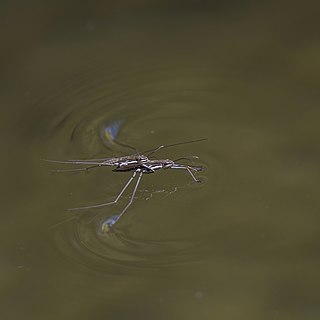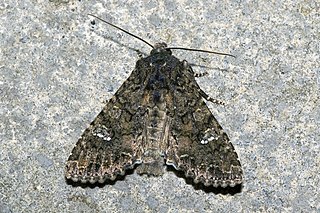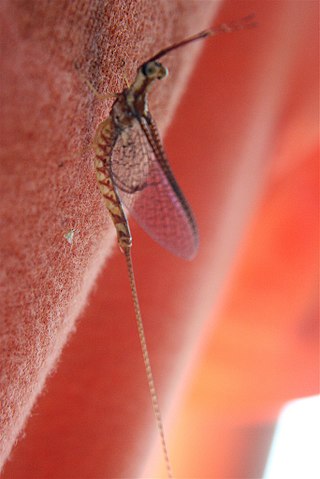
Odonata is an order of predatory flying insects that includes the dragonflies and damselflies. The two groups are distinguished with dragonflies usually being bulkier with large compound eyes together and wings spread up or out at rest, while damselflies are usually more slender with eyes placed apart and wings folded together along body at rest. Adult odonates can land, but rarely walk.

Damselflies are flying insects of the suborder Zygoptera in the order Odonata. They are similar to dragonflies but are smaller and have slimmer bodies. Most species fold the wings along the body when at rest, unlike dragonflies which hold the wings flat and away from the body. Damselflies have existed since the Jurassic, and are found on every continent except Antarctica.

Mayflies are aquatic insects belonging to the order Ephemeroptera. This order is part of an ancient group of insects termed the Palaeoptera, which also contains dragonflies and damselflies. Over 3,000 species of mayfly are known worldwide, grouped into over 400 genera in 42 families.

The black-tailed skimmer is a dragonfly belonging to the family Libellulidae.

The luna moth, also called the American moon moth, is a Nearctic moth in the family Saturniidae, subfamily Saturniinae, a group commonly named the giant silk moths.

The Gerridae are a family of insects in the order Hemiptera, commonly known as water striders, water skeeters, water scooters, water bugs, pond skaters, water skippers, water gliders, water skimmers or puddle flies. Consistent with the classification of the Gerridae as true bugs, gerrids have mouthparts evolved for piercing and sucking, and distinguish themselves by having the unusual ability to walk on water, making them pleuston (surface-living) animals. They are anatomically built to transfer their weight to be able to run on top of the water's surface. As a result, one could likely find water striders present in any pond, river, or lake. Over 1,700 species of gerrids have been described, 10% of them being marine.

The blue-tailed damselfly or common bluetail is a damselfly, belonging to the family Coenagrionidae.

The cabbage moth is primarily known as a pest that is responsible for severe crop damage of a wide variety of plant species. The common name, cabbage moth, is a misnomer as the species feeds on many fruits, vegetables, and crops in the genus Brassica. Other notable host plants include tobacco, sunflower, and tomato, making this pest species particularly economically damaging.

Dryinidae is a cosmopolitan family of solitary wasps. Its name comes from the Greek drys for oak: Latreille named the type genus Dryinus because the first species was collected in an oak plant in Spain. The larvae are parasitoids of the nymphs and adults of Auchenorrhyncha. Dryinidae comprises approximately 1900 described species, distributed in 17 subfamilies and 53 genera.

Ephemera danica, the green drake or green drake mayfly, is a species of mayfly in the genus Ephemera.

The marsh bluet is a damselfly species in the family Coenagrionidae.

Progomphus borealis is a species of dragonfly in the family Gomphidae. This dragonfly species is commonly known as the gray sanddragon.

Gomphurus externus, the plains clubtail, is a species of dragonfly in the family Gomphidae.

Lygus pratensis is a species of plant bug belonging to the family Miridae.

Siphlonurus lacustris is a species of mayfly belonging to the family Siphlonuridae. This species is present in most of Europe.

Coxoplectoptera or "chimera wings" is an extinct order of stem-group mayflies containing one family, Mickoleitiidae.

Pholidoptera griseoaptera, the dark bush-cricket, is a flightless species of European bush-cricket; it is the type species of its genus with no subspecies.
Dolania is a monotypic genus of mayfly in the family Behningiidae containing the single species Dolania americana, also known as the American sand-burrowing mayfly. It is found in the southeastern United States, as far south as Florida, and is generally uncommon. The adult insects emerge before dawn in early summer, mate and die within the space of about thirty minutes. The female deposits her eggs in the water and dies within five minutes of emergence. This is believed to be the shortest adult lifespan of any insect.

Hexagenia limbata, the giant mayfly, is a species of mayfly in the family Ephemeridae. It is native to North America where it is distributed widely near lakes and slow-moving rivers. The larvae, known as nymphs, are aquatic and burrow in mud and the adult insects have brief lives. They are often referred to as fish flies around the Great Lakes as they tend to cause the areas around water to smell like rotten fish.

Euthyrhynchus floridanus, the Florida predatory stink bug, is a species of carnivorous shield bug in the family Pentatomidae, the only species in the genus Euthyrhynchus. It is native to the hottest parts of the southeastern United States and is considered beneficial because it feeds on many species of pest insects. They also feed on things such as grasshoppers and other small insects. This species also hunts in a pack, with up to twelve.



















